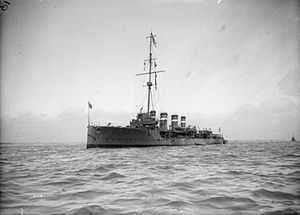HMS Blonde (1910)
 HMS Blonde at anchor | |
| Career (United Kingdom) | |
|---|---|
| Name: | HMS Blonde |
| Builder: | Pembroke Royal Dockyard |
| Laid down: | 6 December 1909 |
| Launched: | 22 July 1910 |
| Completed: | May 1911 |
| Fate: | Sold for scrap, 6 May 1920 |
| General characteristics | |
| Class and type: | Blonde-class scout cruiser |
| Displacement: | 3,350 long tons (3,400 t) (normal) |
| Length: | 406 ft (123.7 m) (o/a) |
| Beam: | 41 ft 6 in (12.6 m) |
| Draught: | 14 ft 3 in (4.3 m) |
| Installed power: | 18,000 shp (13,000 kW) 12 × Yarrow boilers |
| Propulsion: | 4 × shafts 4 × Parsons steam turbines |
| Speed: | 25 knots (46 km/h; 29 mph) |
| Complement: | 317 |
| Armament: | 10 × single BL 4-inch (102 mm) guns 4 × single QF 3-pounder (47 mm (1.9 in)) guns 2 × single 21-inch (530 mm) torpedo tubes |
| Armour: |
|
HMS Blonde was the lead ship of the Blonde-class scout cruisers built for the Royal Navy in the first decade of the 20th century. She led the 7th Destroyer Flotilla in the Mediterranean Fleet from completion until 1912. During the First World War, she was assigned to battleship squadrons of the Grand Fleet. The ship was converted into a minelayer in 1917, but never actually laid any mines. She was sold for scrap in 1920.
Design and description
Designed to provide destroyer flotillas with a command ship capable of outclassing enemy destroyers with her 10 four-inch (102 mm) guns, Blonde proved too slow in service from the start of her career. Her 25-knot (46 km/h; 29 mph) speed was inadequate to match the speeds of the destroyers she led in her flotilla.[1]
Displacing 3,350 long tons (3,400 t),[1] the ship had an overall length of 406 feet (123.7 m), a beam of 41 feet 6 inches (12.6 m) and a deep draught of 14 feet 3 inches (4.3 m). She was powered by four Parsons steam turbines, each driving one shaft. The turbines produced a total of 18,000 indicated horsepower (13,000 kW), using steam produced by 12 Yarrow boilers, and gave a maximum speed of 25 knots (46 km/h; 29 mph). She carried a maximum of 780 long tons (790 t) of coal and 189 long tons (192 t) of fuel oil.[2] Her crew consisted of 314 officers and enlisted men.[1]
Her main armament consisted of 10 breech-loading (BL) four-inch Mk VII guns. The forward pair of guns were mounted side by side on a platform on the forecastle, three pairs were port and starboard amidships, and the two remaining guns were on the centreline of the quarterdeck, one ahead of the other.[1] The guns fired their 31-pound (14 kg) shells to a range of about 11,400 yards (10,400 m).[3] Her secondary armament was four quick-firing (QF) three-pounder (47 mm (1.9 in)) Vickers Mk I guns and two submerged 21-inch (530 mm) torpedo tubes.[1]
As a scout cruiser, the ship was only lightly protected to maximize her speed. She had a curved protective deck that was one inch (25 mm) thick on the slope and .5 inches (13 mm) on the flat.[2] Her conning tower was protected by four inches of armour.[1]
Construction and service
Blonde, the eighth and last ship of that name,[4] was laid down at Pembroke Royal Dockyard, on 6 December 1909 and launched on 22 July 1910. She was completed in May 1911 and became the leader of the 7th Destroyer Flotilla in the Mediterranean through 1912.[1] She was assigned to the 4th Battle Squadron of the Grand Fleet in Scapa Flow at the start of the war and remained with it until detached before the Battle of Jutland in May 1916. She did not participate in the battle. Blonde was still detached in August.[5] In September 1917, she was converted into a minelayer, but never laid any mines in combat.[1] She was sold for scrap on 6 May 1920 to T. C. Pas, and was broken up in the Netherlands.[4]
Notes
Bibliography
- Colledge, J. J.; Warlow, Ben (2006) [1969]. Ships of the Royal Navy: The Complete Record of all Fighting Ships of the Royal Navy (Rev. ed.). London: Chatham Publishing. ISBN 978-1-86176-281-8. OCLC 67375475.
- Corbett, Julian. Naval Operations to the Battle of the Falklands. History of the Great War: Based on Official Documents I (2nd, reprint of the 1938 ed.). London and Nashville, Tennessee: Imperial War Museum and Battery Press. ISBN 0-89839-256-X.
- Corbett, Julian (1997). Naval Operations. History of the Great War: Based on Official Documents II (reprint of the 1929 second ed.). London and Nashille, Tennessee: Imperial War Museum in association with the Battery Press. ISBN 1-870423-74-7.
- Friedman, Norman (2009). British Destroyers From Earliest Days to the Second World War. Annapolis, Maryland: Naval Institute Press. ISBN 978-1-59114-081-8.
- Friedman, Norman (2011). Naval Weapons of World War One. Barnsley, South Yorkshire, UK: Seaforth. ISBN 978-1-84832-100-7.
- Gardiner, Robert & Gray, Randal, eds. (1984). Conway's All the World's Fighting Ships: 1906–1921. Annapolis, Maryland: Naval Institute Press. ISBN 0-85177-245-5.
- Newbolt, Henry (1996). Naval Operations. History of the Great War Based on Official Documents IV (reprint of the 1928 ed.). Nashville, Tennessee: Battery Press. ISBN 0-89839-253-5.
External links
| ||||||||||